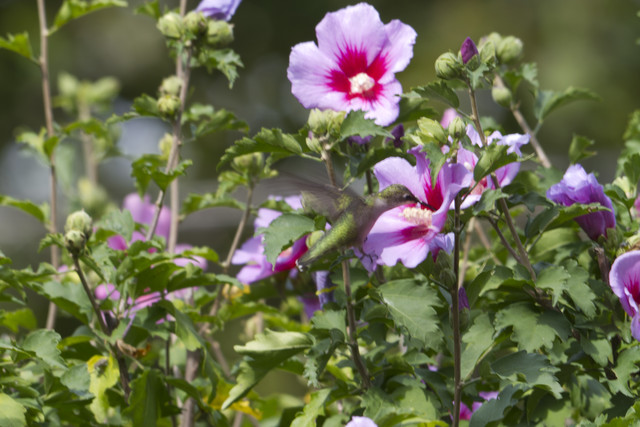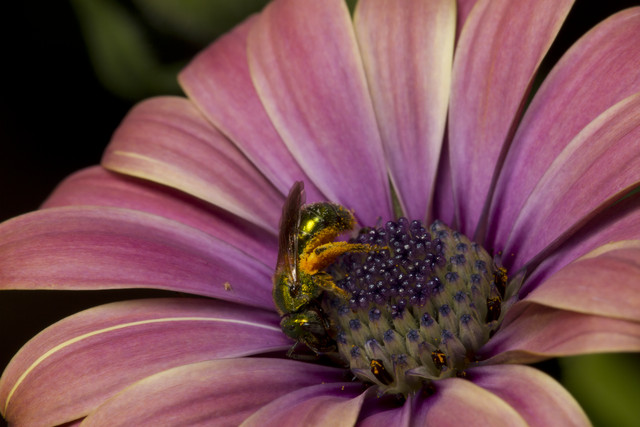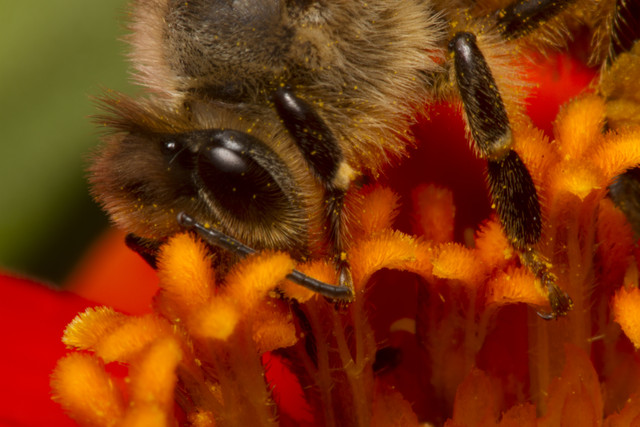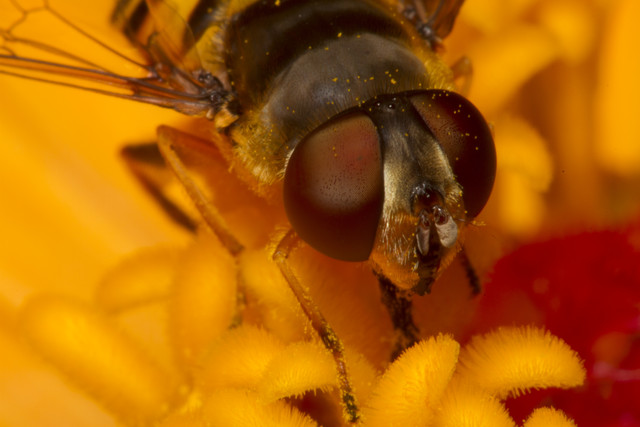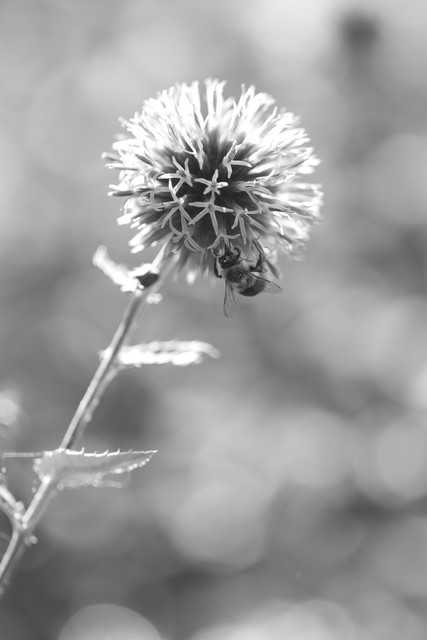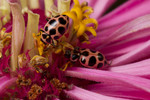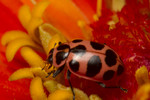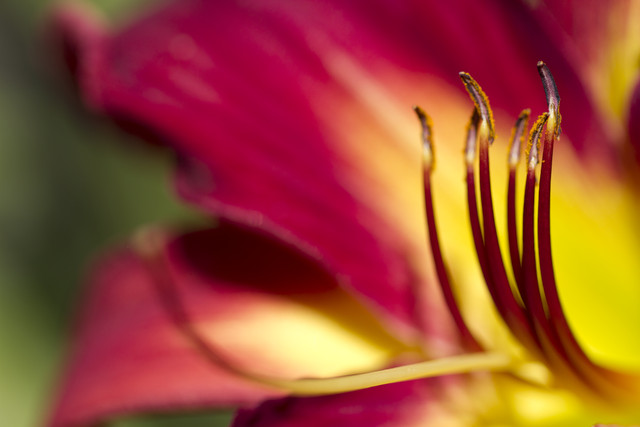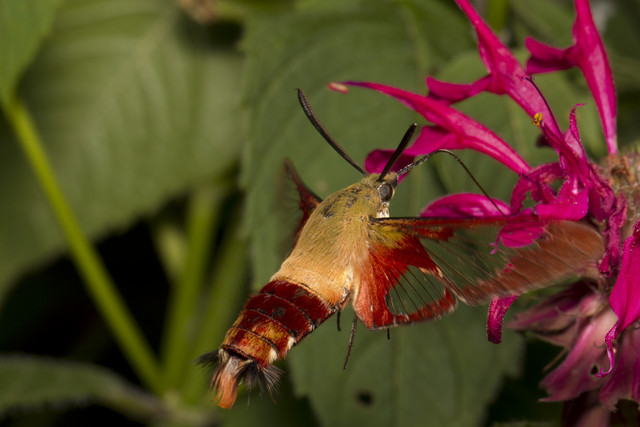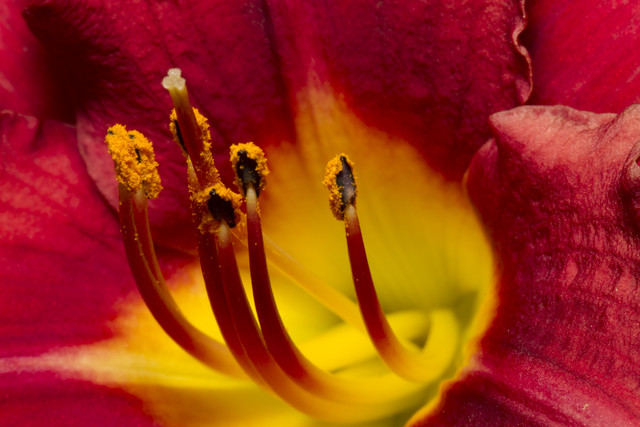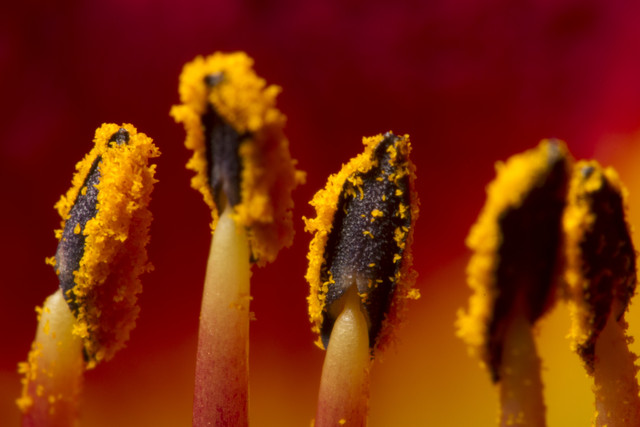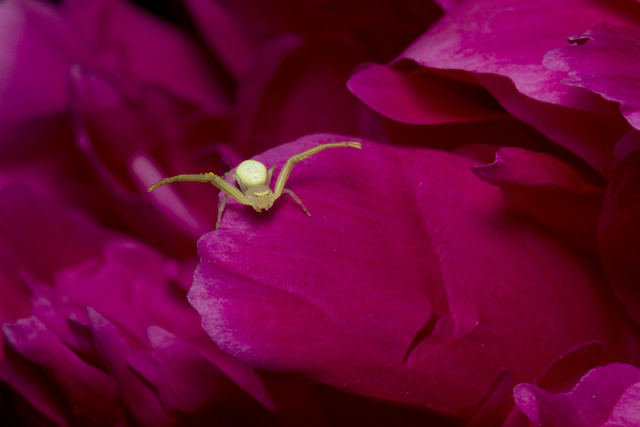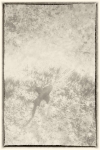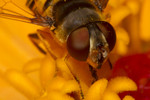flowers
Crab Spider on Dahlia
ktuli — Mon, 09/19/2011 - 20:05
Just another quick photo to share again today... I've been putting in a ton of extra hours at work, and it is just so mentally draining that it is having a physical toll too. Can't wait to get to this trip coming up and relax for a bit.
Anyway, it has been a bit since we've done a spider shot, so we'll take a look at a cool crab spider on a dahlia bud. I'd seen (and shot) several of these crab spiders this summer, and having this one on this richly colored dahlia was just so nice. I probably should crop it differently, but for now, here's the shot right out of the camera (with RAW processing of course)....
Technical Data: Canon EOS 7D, Canon EF 100mm f/2.8L Macro IS USM, 1/250 sec at f/16. Canon Speedlight 580EX II flash in auto mode and wireless control. Image Stabilization on. ISO 100. RAW processing and cropped in Adobe Camera Raw.
I think after jumping spiders, crab spiders are my second favorite variety of spiders.
- Bill
First Hummingbird Shot
ktuli — Sat, 09/03/2011 - 19:21
So we've managed to get a hummingbird to be a regular visitor to our yard this summer. So one Sunday morning after I got home from playing hockey, I noticed her stopping by the feeder and rose of sharon bushes. So I quickly went and got my camera with the Sigma 150-500 and my new tripod (have I mentioned that yet? I don't think I have! I guess I should get around to talking about that at some point, but not right now).
Anyway, I setup and managed to get just a few shots before she wandered off again and I had to go work on some bathroom tile repair work. Unfortunately, I totally did not think things through, and I used a rather slow shutterspeed of 1/30th of a second. Far too slow to keep such a fast moving subject from blurring.
But considering they were my first ever hummingbird shots, I kept a couple just the same...
Technical Data:Canon EOS 7D, Sigma 150-500mm f/5-6.3 APO DG OS HSM at 500mm, 1/30 sec at f/11. OS mode off. ISO 100. Raw processing in Photoshop CS5.
Sorry - no mouseovers for a cropped view on this one... it would just show you just how bad the blur is. At least at the smaller version, it makes it a little tougher to see the blur.
Hopefully I'll get another chance at this before the end of summer and she leaves for warmer climates... next time I'll know to use a faster shutterspeed!
- Bill
Pollen Covered Sweat Bee
ktuli — Thu, 08/11/2011 - 20:44
Ok - sorry, just doing another very quick post today...
Technical Data: Canon EOS 7D, Canon EF 100mm f/2.8L Macro IS USM, 1/250 sec at f/16. Canon Speedlight 580EX II flash in auto mode and wireless control. Image Stabilization on. ISO 100. RAW processing and cropped in Adobe Camera Raw.
This is a green sweat bee (Agapostemon texanus) - for obvious reasons... well, at least the green part. I was quite happy that the shot captured the metallic qualities of this bee, and I was just drawn to the shot because of all that pollen covering its legs.
Thanks for stopping by.
- Bill
Five Eyes
ktuli — Sun, 08/07/2011 - 19:13
Ok - while we're on the subject of weird bug trivia... did you know that bees and some flies have five eyes? I knew spiders had eight, but I always thought bees only had two. Until this weekend, when I managed to get a super-macro shot of a bee and a fly and I could see the additional eyes.
Here you can see the bee digging in to get to the nectar of this flower. To the left of the large eye you're used to seeing, you can see the reflection of my flash on one of the other eyes. I was trying for a shot of more of the bee's face, but she was so intent on getting to the nectar that she only ever picked her head up for fractions of a second and was moving quickly whenever she did - the only time she would hold still for any amount of time was while she was feeding.
Technical Data: Canon EOS 7D, Canon EF 100mm f/2.8L Macro IS USM with Kenko Teleplus PRO 300 "DG" AF 2x Teleconverter, 1/250 sec at f/16. Canon Speedlight 580EX II flash in auto mode and wireless control. Image Stabilization on. ISO 160. RAW processing in Adobe Camera Raw.
In this next shot, a fly was feeding the same way, and I was able to get a shot of it. I know it isn't the best of subjects, but I am fascinated by the compound eyes on insects like this, and feel getting the focus right to show the multiple facets of those eyes as a challenge. In this resized version, it isn't the easiest to see, but in the fullsize version, they are plainly visible. Also visible are the three simple eyes in a triangular pattern between the two large compound eyes.
Technical Data: Canon EOS 7D, Canon EF 100mm f/2.8L Macro IS USM with Kenko Teleplus PRO 300 "DG" AF 2x Teleconverter, 1/250 sec at f/16. Canon Speedlight 580EX II flash in auto mode and wireless control. Image Stabilization on. ISO 160. RAW processing in Adobe Camera Raw.
I guess we're two-for-two for that whole "learn something new every day" thing...
- Bill
Poll: High Key Blue Globe Thistle
ktuli — Thu, 08/04/2011 - 16:57
Ok - here's a new one for me. High Key Photography is a style of photography that is generally bright and eliminates any shadows. When I saw this Blue Globe Thistle (Echinops_sphaerocephalus) with this nice back lightning, I decided to crank up the bokeh with a wide aperture and see what I could get.
Due to the proximity of the other thistles, it was really tough to frame it, so I took a couple shots. The first version ended up with an incoming bee in the background that was distracting. The second version was better with the bee having landed on the flowers, but I wasn't as thrilled with the framing. So I took one more shot which ended up with just an edge of the next flower in the frame. I used Photoshop's content aware fill to eliminate the out of focus bee and the other flower as well as to convert each to black and white....
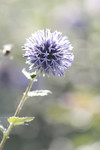 Version 1 SOOC |
|
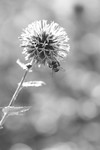 Version 2 B&W |
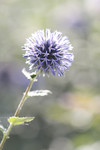 Version 1 Fixed |
 Version 3 SOOC |
|
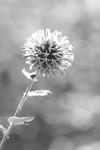 Version 1 Fixed B&W |
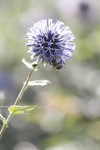 Version 3 Fixed |
|
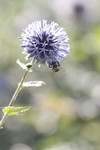 Version 2 SOOC |
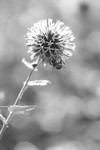 Version 3 Fixed B&W |
Technical Data: Canon EOS 7D, Canon EF 100mm f/2.8L Macro IS USM, 1/250 sec at f/2.8 Image Stabilization on. ISO 100.
So I know this is tough with this many choices, but take a look through the different versions and vote to pick which one you like best. Then leave a comment to let me know what made you choose the one you did.
- Bill
Pink Spotted Ladybug
ktuli — Tue, 08/02/2011 - 20:18
Have you ever seen a Pink Spotted Ladybug (Coleomegilla maculata)? Before last Sunday, neither had I.
Ladybugs are good insects to have in your garden. They eat aphids, and thus keep your plants safe. Most people are used to the orange variety, so when we found these pink ones, it was worth a few shots.
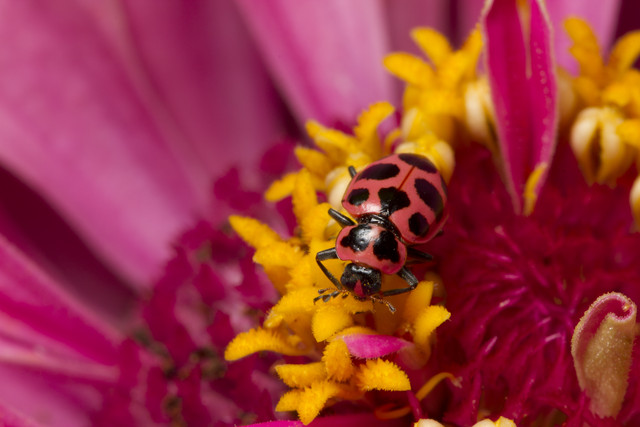
I'm not sure if that last one was really that color or if I messed something up during the RAW conversion. I don't remember it being that dark, but as you can see they seemed to be different shades based on what color flower they were on. I don't know if that is because they can shift their colors or if it is an optical illusion.
- Bill
Depth of Field: Day Lily
ktuli — Wed, 07/20/2011 - 18:07
Alright, as promised, here are some more flower photos.
As I was shooting these day lilies, I tried several different apertures for different looks. Then I decided I would shoot a whole series and possibly print them for a framed set. Unfortunately, I don't think they work well to be framed, but it will work nicely to explain aperture and depth of field.
First - every camera lens has an aperture. It is the opening that allows the light to pass through the lens into the camera. Opening the aperture allows more light in, closing it allows in less light. Aperture values are represented in f/# notation. That notation is actually an equation - focal length of the lens / aperture value. So, if you have an 80mm lens, and select an aperture of f/8, that means that the opening to let the light in is 10mm. Bump up to f/16, and the opening drops down to 5mm.
So how does that apply to depth of field? Well, to start, let's define depth of field... in simplest terms, it is the amount of the scene that is in clarity (not necessarily focus, but we'll leave that for another time). The amount of depth of field is directly related to the aperture. Select a lower aperture value, and you get less depth of field; select a higher aperture value, and you get more depth of field. If you think of it in those terms, it is extremely simple. f/2.8 is going to have much less depth of field than f/16.
Where some folks get confused is when they look at the aperture sizes in relation to the f/# notation. f/2.8 is a very large aperture opening, f/16 is a small opening. Remember - that is because it is an equation, so a larger denominator produces a smaller result (remember your algebra?). However, if you think about it in terms of depth of field, it is somewhat easier to keep straight. Small f/# gives a small amount of depth of field; large f/# gives a larger depth of field.
Here is a good way to understand how a larger aperture opening (small f/#) gives more depth of field than a smaller aperture opening (large f/#) - say you have a bunch of M&Ms and you want to keep track of how many of each color come through an opening. If you have a large opening (large aperture/small f/#), it will be very hard to keep track of each individual candy that comes through, so you do some guestimating. Switch to a smaller opening (smaller aperture/larger f/#) and only a few candies will come through at a time, making your count much more detailed.
The trade off? It will take a lot longer to count the same number of M&Ms with a smaller opening. The same is true of photography and apertures and shutter speed... but we'll discuss that more later.
So take a look at these shots. Mouseover each aperture, and it will show the depth of field provided by that aperture. Slide along the apertures to see the progression. Compare the aperture size with the depth of field. When you get into the higher apertures, the difference is not as drastic, but look to the green plants in the background on the left for the difference.
Make sense? I think I'll probably keep an eye out for other good examples and do this kind of explanation again some time. At the very least, I'll have to show how shutter speed factors into things.
Drop me a comment and let me know what you think of this kind of post. Was it helpful? Was it confusing? Let me know.
Thanks for stopping by.
- Bill
Hummingbird Moth (part 1)
ktuli — Tue, 07/19/2011 - 19:43
Ok - a slight bounce back to the bugs today. I have another day of flower photos to do, but it is a much more in-depth post with discussion of apertures and depth of field, so I want to take my time with it and hopefully make it clear to understand and useful for folks.
So instead, you get a sneak peak at a hummingbird moth photo.
Technical Data: Canon EOS 7D, Canon EF 100mm f/2.8L Macro IS USM, 1/250 sec at f/16. Canon Speedlight 580EX II flash in auto mode and wireless control. Image Stabilization on. ISO 160. RAW processing in Adobe Camera Raw.
Did you do the double take? Did you think that was a hummingbird? Look again... notice the antennae and the extra legs?
I'll tell you more about hummingbird moths in a few days. Stay tuned.
- Bill
Day Lily Pollen Stamens
ktuli — Mon, 07/18/2011 - 20:33
Ok - as promised - a short break from the spiders.... The other day as I looked around for more creepy-crawlies to shoot, I turned my attention to some of the day lilies in our yard and took some shots focusing on their pollen stamens.
Technical Data: Canon EOS 7D, Canon EF 100mm f/2.8L Macro IS USM with Kenko Teleplus PRO 300 "DG" AF 2x Teleconverter, 1/250 sec at f/16. Canon Speedlight 580EX II flash in auto mode and wireless control. Image Stabilization on. ISO 160. RAW processing in Adobe Camera Raw.
And some getting really up close and personal with the pollen in an exercise in super-macro....
Technical Data: Canon EOS 7D, Canon EF 100mm f/2.8L Macro IS USM with Kenko Teleplus PRO 300 "DG" AF 2x Teleconverter, 1/250 sec at f/16. Canon Speedlight 580EX II flash in auto mode and wireless control. Image Stabilization on. ISO 160. RAW processing in Adobe Camera Raw.
Hope this helps counter balance the week of spider shots, but I have more spiders to share soon, so probably not... (sorry!)
- Bill
Return of the Crab Spider (part 2)
ktuli — Tue, 06/07/2011 - 17:16
Ok - back to the crab spider that was living in one of the peony flowers in our garden for today. This was a very tiny little spider, and today's shot gives a little more scale by backing up a little and showing more of the flower along with the spider.
Technical Data: Canon EOS 7D, Canon EF 100mm f/2.8L Macro IS USM, 1/250 sec at f/16. Canon Speedlight 580EX II flash in auto mode and wireless control. Image Stabilization on. ISO 160. RAW processing in Adobe Camera Raw.
By backing up a little, I manage to show a little scale (though nothing near normal size). I think often times, folks think that these bugs I find are the size of my hand because of the magnification the macro lens produces. In reality (and if my math is correct) had an arm span of only about 9-11mm. Pretty tiny.
The other thing this shot shows is some of the behavior of the crab spider. (This part will probably creep out those of you who don't like spiders, so skip the rest of this paragraph if you're in that group). Crab spiders are pretty aggressive. They often take down prey much much larger than themselves, and they do that with those long, powerful, front legs. They lie in wait and pounce on their prey, holding it with those long legs while injecting their venom. Both crab spiders that I have photographed showed basically no fear of me at all, including threat displays and lunging forward towards my hands and the camera. Very impressive little attitudes. Despite their attitudes and ability to take down large prey, they are harmless to humans.
Often times, crab spiders live on flowers that are close to the color they are (some can slightly change their colors to match the flowers exactly), so this little guy living in a pink flower is kind of strange. The camouflage at work here is actually based on the pollen stamens in the flower. When hiding between the petals, this little spider was about the size and color of the yellow pollen stamens which are layered between the different petals in a peony flower. And it was very quick to move around the flower, quickly climbing between petals, crawling from one side to the other side of a petal, and traversing the whole flower with surprising speed - though it never moved very quickly, just very directly.
See - there are reasons why I am fascinated by little critters like this. I know they're often considered creepy or even scary, but they really are interesting creatures.
- Bill


